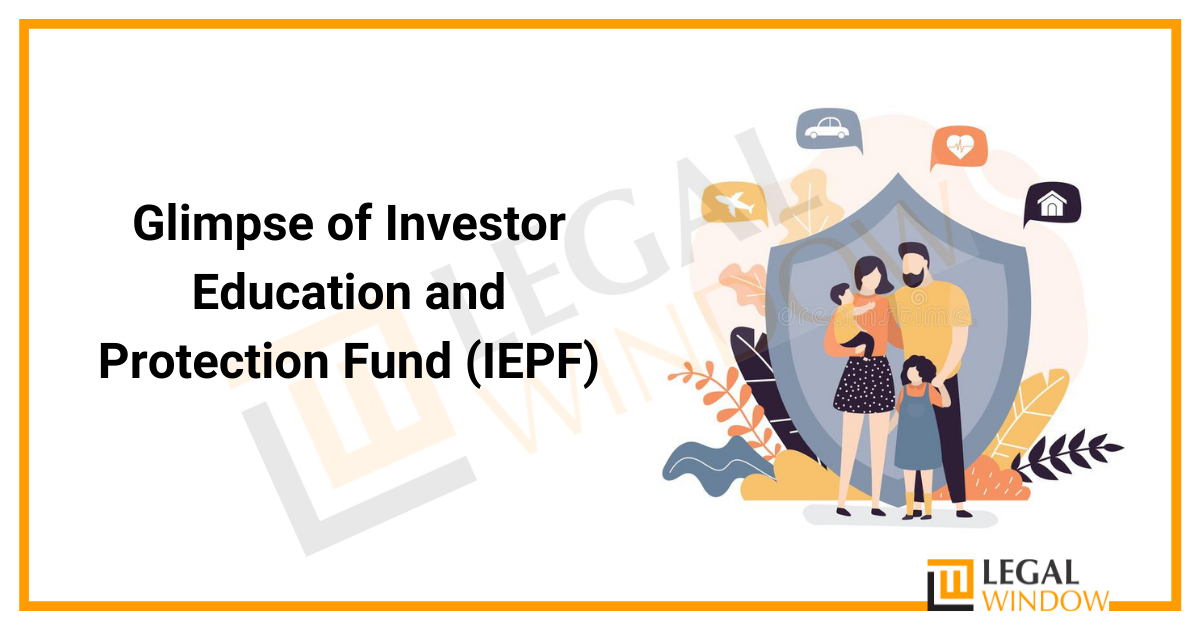
Financial markets heavily depend upon the investors. Investors, investing their excess resources, determine the market trends and the level of activity in the economy. In recent years, the market witnessed the rise of small investors in addition to institutional investors. Where the small investors significantly rise, the scams in the market tend to shake their confidence in the market. As investors are the backbone of the capital market, it is imperative to maintain their confidence. Hence, it became all the more important to develop a credible and transparent corporate system.
To safeguard the interest of the investors, the “Securities and Exchange Board of India (SEBI)” took it upon itself to protect them, promote their development and regulate the operations of the market to strengthen the Indian Economy.
Over time, SEBI undertook various steps to reach the ultimate goal of investors protection. After certain efforts, the Government of India on 7th September 2016 initiates the “Investor Education and Protection Fund Authority” under the supervision of section 205 C of Companies Act, 2013 to educate the investors and protect their interests.
| Table of Contents |
Introduction to Investor Education and Protection Fund (IEPF)
Time and again, SEBI demonstrated its concerns over half-hearted attempts taken by the fund houses to spread awareness about the investors’ rights and to educate them. Additionally, other regulatory bodies like RBI and the Ministry of Corporate Affairs also abligated their divisions such as banks, companies and the stock exchanges to contribute towards educating and protecting investors.
Hence, in a joint attempt to guard the investors, the Government of India formulated the Investor Education and Protection Fund under Section 125 of the Companies Act 2013. Unclaimed dividends, refunded application money, matured company deposits, debentures and the interest on them that remained claimed within seven years forms the said fund. Sub-Section 3(a), 5 and 6 of the said section looks after such a transfer. Further, in line with Article 266 of the Indian Constitution, the Consolidated Fund of India maintains the amount to be transferred to IEPF.
Role of Ministry of Corporate Affairs
The failure of dozens of Ponzi schemes, from pseudo-chit schemes like Saradha to money-laundering episodes masqueraded as deposits, that defrauded investors of their money, highlighted the need for legal provisions sheltering them. So, with the dual aim of formulating investor’s protection schemes and educating them the Ministry of Corporate Affairs established the Investors Education and Protection Fund.
Further, in 2016, the Ministry of Corporate Affairs, through a notification, empowered IEPF to permit investors to claim a refund on their unclaimed rewards The investors could claim such amount through an IEPF-5 form along with other required documents. The fund is built up of dividends and corporate benefits that remained unclaimed for seven years. Previously, the genuine investors had no provisions to claim such an amount. However, the issue was thoroughly discussed and legally fought and hence, finally resulted in a decision in favour of genuine investors.
Objective of IEPF
The formation of the Investors Education and Protection Fund revolves around the investors. The primary purpose would be to maintain their confidence in the market to flourish the financial market. The proceeds from the fund are exclusively used for educating the investors and refunding their claims.
Features of the Fund
- The proceeds from the fund are to be utilized for educating investors about the working of the market.
- Enabling the investors to analyze the market trends by bestowing them with relevant skills to make knowledgeable decisions.
- Spreads awareness about financial market working and trends.
- Empower the investors by tutoring them about their freedoms and liabilities under various legal provisions.
- Promulgating information about unethical and unfair practices prevalent in the securities markets.
- Motivating new investors to invest in the securities market.
- Developing the culture of research and investor surveys to widen the knowledge base to facilitate informed policy decisions.
IEPF Funds
The Funds transferred to the IEPF are utilized towards the distribution of disgorged amounts. Eligible applicants such as shareholders, debenture-holders or depositors enduring losses as a result of wrong actions are eligible to get a claim through the decision declared by the Court. An individual or entity earning fraudulent profits in financial markets could receive a “disgorgement order” to repay those fraudulent gains to affected investors with interest. The proceeds of the fund are utilized towards-
- Payment of abandoned dividends, matured deposits and debentures.
- Remission of application money to be refunded along with the interest.
- Commencing schemes for promoting investors’ rights and protection.
- The settlement of “disgorged amount” following the “disgorgement orders” made by the court.
- Indemnification of legal expenses by members, debenture holders or depositors incurred under sections 37 and 245 of companies act 2013.
Amounts from various sources are credited to IEPF Funds. Some of them are-
- Central Government’s grants
- Donations by Central and State Governments, Corporations and other institutions.
- Unpaid dividends available with the Companies
- Unclaimed and unpaid general revenue of central government before the commencement of Companies Amendment Act 1999, with respect to subsection 5 of section 205A of companies act 1956.
- Unutilized amount in Investor Education and Protection Fund under section 205C of companies act 1956.
- Excess of application money due for refund.
- Matured deposits of companies except for the banking companies.
- Unclaimed redemption amount of preference shares for seven or more years and such other amount as may be prescribed.
IEPF Authority
Central Government formed Investor Education and Protection Fund authority with a maximum of seven members that comprise of the Chairperson, that shall be the secretary of Ministery of Corporate Affairs, CEO, Executive Director, to be nominated by RBI and SEBI as an ex-officio member and other members with more than 15 years of experience in finance, management, accountancy or the law.
IEPF Authority administers the IEPF, educates the investors about fair and safe investing, ensures the repayment of the disgorged amounts such as shares, unclaimed dividends, matured deposits/debentures to investors.
IEPF Authority conducts timely awareness programmes that are necessary and beneficial for educating investors and protecting them. Their partner Institutions & “CSC e-governance Services India Ltd, and Ministry of Communications & IT” help in the initiation of such awareness schemes. Several awareness programs were conducted in association with organizations such as “ICAI, Institute of cost accountants of India, ICSI, Institute of corporate affairs and National Foundation for Corporate Governance”.
Investor Awareness Program (IAP)
Investor Awareness Programs or IAP’s are organized by Investor Education and Protection Fund Authority in association with various partners to create financial literacy and spread massive awareness by the way of drives throughout rural, semi-urban & urban areas.
Essentials
- A minimum participation of a hundred per IAP, organized by PI.
- Inviting MP/MLA/local public representatives along with an officer from the concerned ROC.
- Programs to be organized in districts and towns by Resource Persons (RP).
- Submission of the write-up, photographs and attendance sheets by RP’s and PI’s to the authority & the same should concerning be uploaded on the IEPF portal.
Conclusion
The uncertain bearish and bullish trends of the financial markets are detrimental to the investors making investors. In absence of coherent laws, the corporations have manipulated the loopholes and violated the investors.
With the growth of the capital market, it became all the more important to shield the investors from these uncertain trends and to provide a safe environment to operate it in. Hence, after multiple failed attempts, the Central Government formulated the Investors Education and Protection Fund that not only protects the investors but also educate them about the market. The fund works extensively to bridge the gap between the investors and markets and ensures that investors are safeguarded in every manner. Strong investors lead to a strong market and economy, which is the guiding principle of the IEPF.
CS Urvashi Jain is an associate member of the Institute of Company Secretaries of India. Her expertise, inter-alia, is in regulatory approvals, licenses, registrations for any organization set up in India. She posse’s good exposure to compliance management system, legal due diligence, drafting and vetting of various legal agreements. She has good command in drafting manuals, blogs, guides, interpretations and providing opinions on the different core areas of companies act, intellectual properties and taxation.
Categories
- Agreement Drafting (23)
- Annual Compliance (11)
- Change in Business (36)
- Company Law (148)
- Compliance (89)
- Digital Banking (3)
- Drug License (3)
- FEMA (17)
- Finance Company (42)
- Foreign Taxation (6)
- FSSAI License/Registration (14)
- GST (118)
- Hallmark Registration (1)
- Income Tax (199)
- Latest News (34)
- Miscellaneous (164)
- NBFC Registration (8)
- NGO (14)
- SEBI Registration (6)
- Section 8 Company (7)
- Start and manage a business (20)
- Startup/ Registration (127)
- Trademark Registration/IPR (40)
Recent Posts
- Farmer Producer Companies-Major provisions under Companies Act April 26, 2024
- Detailed Analysis of Section 179 of the Companies Act, 2013 April 24, 2024
- Maximise Your Tax Savings: Power of Form 12BB April 23, 2024
About us
LegalWindow.in is a professional technology driven platform of multidisciplined experts like CA/CS/Lawyers spanning with an aim to provide concrete solution to individuals, start-ups and other business organisation by maximising their growth at an affordable cost.








